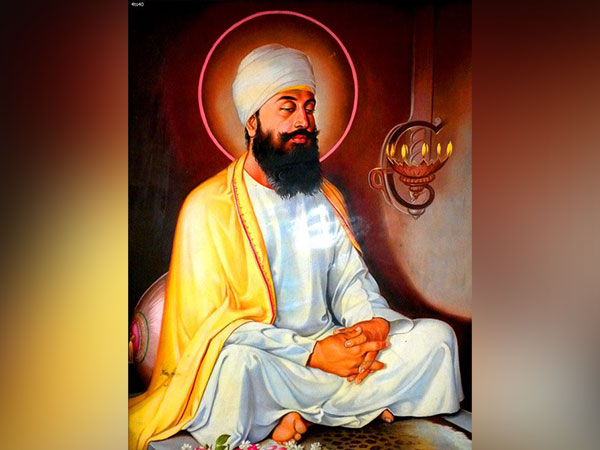At a time when the world is filled with conflict and everyone is focused on interfaith harmony, the legacy of Guru Tegh Bahadur shows us the way. Guru Tegh Bahadur, the ninth Sikh Guru, sacrificed his life while protecting Hindus from persecution. His martyrdom, Shaheedi Divas, is commemorated every year on November 24th.
Earned the Name and Lived to It
In 1635, 14-year-old Tyag Mal, a young Sikh boy, stood ready with his sword drawn. He and hundreds of brave Sikhs guarded the village of Kartarpur in Punjab, India, led by their fearless leader, the sixth Sikh Guru, Tyag Mal’s father – Guru Hargobind. They anticipated an attack from the Mughal army, and soon enough, thousands of Mughal soldiers swarmed the village. Under the dark night sky, the clash of swords and spears filled the air. With just a sword and a heart full of courage, Tyag Mal fought with incredible bravery. The Sikh army emerged victorious in the battle. For his fearless spirit, Tyag Mal’s father and Guru renamed him Tegh Bahadur, meaning “Might of the Sword.”
Guru Tegh Bahadur was trained as a warrior by his father and bravely fought in many battles led by Guru Hargobind, defending their faith against the Mughal Empire’s persecution.
A Sikh Guru Who Fought for Hindus
A group of Hindu Pandits from Kashmir asked Guru Tegh Bahadur for help against Mughal emperor Aurangzeb’s harsh policies, and the Guru agreed to protect their rights. According to Trilochan Singh in “Guru Tegh Bahadur: Prophet and Martyr,” 500 Kashmiri Pandits, led by Pandit Kirpa Ram, tearfully pleaded with the Guru at Anandpur. They told him about the religious oppression they faced under Iftikhar Khan’s rule. Guru Tegh Bahadur left Makhowal to confront the Mughal officials persecuting the Kashmiri Pandits, but he was arrested in Ropar and imprisoned in Sirhind.
Unshaken Faith until Death
Four months later, in November 1675, he was taken to Delhi and ordered to perform a miracle to prove his connection to God or convert to Islam. The Guru refused, and three of his companions were tortured to death in front of him: Bhai Mati Das was sawed in half, Bhai Dayal Das was thrown into boiling water, and Bhai Sati Das was cut into pieces. On November 11, 1675, Guru Tegh Bahadur was publicly beheaded in Chandni Chowk, a market near the Red Fort. The execution site is today marked by the Gurudwara Sis Ganj Sahib in Chandni Chowk.
A Fierce Defiant Declaration
The Sri Gur Pratap Prakash, written between 1835 and 1843 by Kavi Santokh Singh, a famous Sikh historian, records Guru Tegh Bahadur making the following defiant declaration when he was given the choice between death and converting to Islam:
Rashi 12, Ang 474, Verse 34 ||
Tin te suni Siri Tegh Bahadar, Dharam nibaahani bikhai Bahadar
Uchatar bhano dharam hum Hindu, Ati priya ko kim karahi nikandu ||
Listen All! Said Tegh Bahadur: Those who stick to their Dharma are called brave. I know my Hindu Dharma to be the best. How can I forsake that which is very dear to me?
Rashi 12, Ang 474, Verse 35 ||
Lok parlok bikhai sukhdani, Aan na paiyati jaanahi samaani
Mati mileen murakh mati joi, Ise taagahi paamar soi ||
It (Hindu Dharma) gives immense joy in this world and the next. Even life is trivial compared to honor. The fool whose intellect is corrupted, That idiot alone will forsake it.
Rashi 12, Ang 475, Verse 6 ||
Hindu dharam rakhe jag mahin Tumre kare binse iha nahin ||
I will endure harm to establish Hindu Dharma in this world. It will never be destroyed even if you try.
Committed to Serving Communities
Guru Tegh Bahadur dedicated his life to serving humanity and upholding the principles of religious freedom and tolerance. He traveled extensively across India, preaching the message of love, peace, and equality.
Guru Tegh Bahadur championed religious freedom: He stood up against religious persecution and sacrificed his life to protect the rights of Hindus who were being forced to convert to Islam. He established several Sikh communities and built Gurdwaras (Sikh places of worship) where people could gather to pray and receive spiritual guidance.
He established Langars (community kitchens) where people of all faiths could receive free meals, regardless of their social or economic status. He encouraged education and learning, emphasizing the importance of knowledge and wisdom.
Guru Tegh Bahadur’s legacy continues to inspire people around the world to stand up for justice, social harmony, and human rights.
References
https://swarajyamag.com/ideas/did-their-guru-tegh-bahadur-save-our-hindu-dharma
https://voiceofindia.me/wp-content/uploads/2024/07/hindu-sikh-relationship-ram-swarup.pdf
Disclaimer: The views and opinions expressed here are those of the authors and do not necessarily reflect the official policy or position of VOH. Any content provided by our contributors or authors is their opinion.

